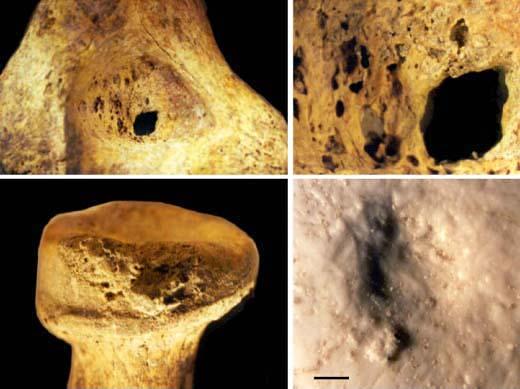Bones from Kennewick Man
In 1996, the skeletal remains of a prehistoric man were found on the bank of the Columbia River near Kennewick, Washington. An archaeologist determined that the man -- referred to as "Kennewick Man" -- had lived 9,200 years ago and died of a projectile wound to the head. These photos from the National Park Service show close-up images of some of Kennewick Man's bones.
The most recent issues with Kennewick Man have to do with who owns the bones. The Native American Graves Protection and Repatriation Act (NAGPRA) orders that public agencies and organizations that hold Native American remains and religious items must contact the respective tribes to determine the ownership. However, Kennewick man has been under debate because the U.S. District Court declared the bones were not classified as Native American. But, Native American tribes have claimed the bones as their ancestor. In 2014, a physical anthropologist of the Smithsonian claimed the bones were related to the circumpacific groups such as the Ainu and Polynesians. The next year, University of Copenhagen geneticist determined that the bones were most closely related to modern Native Americans.
For more on the Kennewick Man go to:
https://www.nps.gov/archeology/kennewick/walker.HTM
https://www.nps.gov/archeology/kennewick/index.htm
On the debate of Kennewick Man's ownership go to:
https://newsroom.uw.edu/postscript/commentary-trying-learn-lesson-kennew...
https://www.burkemuseum.org/blog/kennewick-man-ancient-one
https://www.smithsonianmag.com/history/kennewick-man-finally-freed-share...

National Parks Services. [Kennewick Man Bones]. 2000. Digital Image. National Parks Services. https://www.nps.gov/archeology/kennewick/walker.HTM (Accessed December 17, 2018).
Public Domain
Public Domain is a copyright term that is often used when talking about copyright for creative works. Under U.S. copyright law, individual items that are in the public domain are items that are no longer protected by copyright law. This means that you do not need to request permission to re-use, re-publish or even change a copy of the item. Items enter the public domain under U.S. copyright law for a number of reasons: the original copyright may have expired; the item was created by the U.S. Federal Government or other governmental entity that views the things it creates as in the public domain; the work was never protected by copyright for some other reason related to how it was produced (for example, it was a speech that wasn't written down or recorded); or the work doesn't have enough originality to make it eligible for copyright protection.